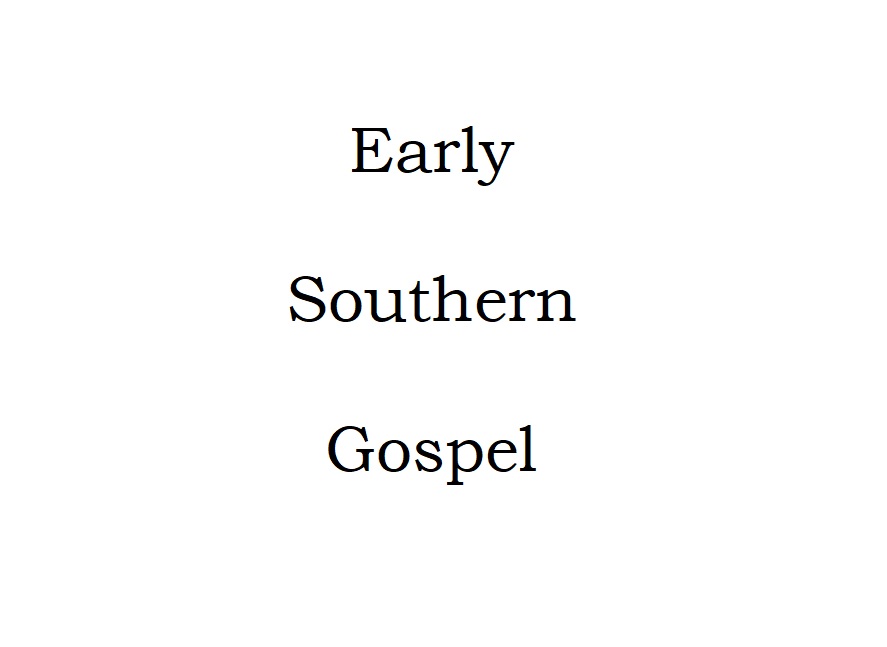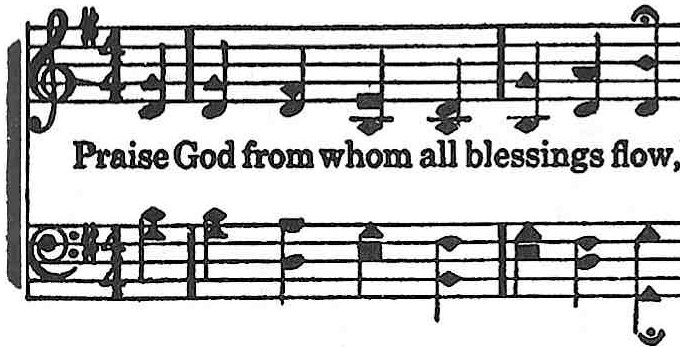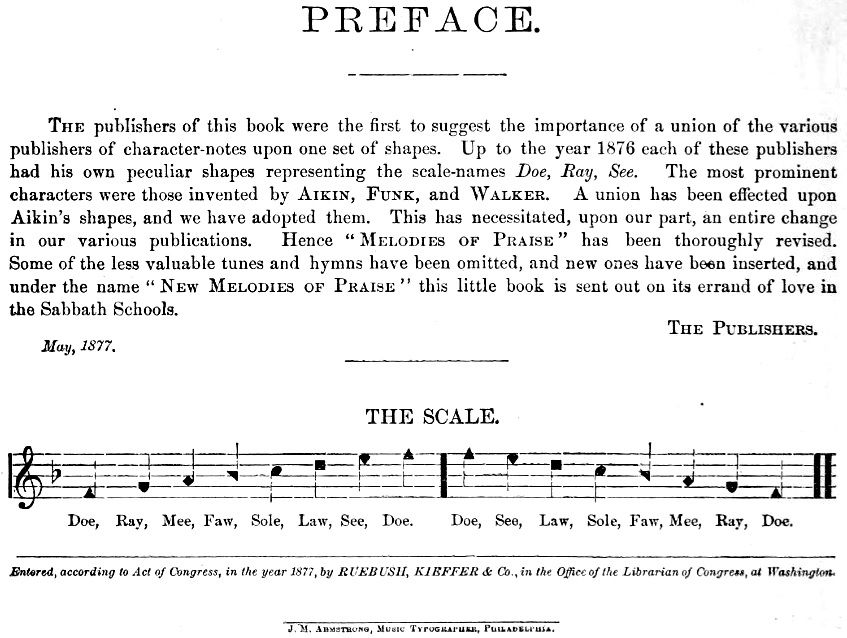



The roots of Southern Gospel singing go back to the 1830s in the Shenandoah Valley town of Singers Glen, Virginia. In 1832, Joseph Funk (1778-1862), the youngest child of a Mennonite minister, published a tune book titled Genuine Church Music. This tune book was intended to be used in the Mennonite worship services. It also used William Little and William Smith's four-syllable shape-note music notation.
Funk's book, like many of the other shape-note books of its time, was oblong in shape, and the music was laid out on three staves. Many of the songs are also found in other tune books, and there are songs that are unique to this book.
Funk revised his book three times.
In 1847, Funk acquired a printing press which allowed him to make major changes for his fifth edition in 1851. He changed the name of the book to Harmonia Sacra. He also changed the shape-note notation to a seven-syllable notation of his own development.

Funk died in 1862, and his sons took over the printing company and the book. Today, the Harmonia Sacra is in its 26th edition.
Funk's grandson, Aldine Sillman Kieffer (1840-1904), and Kieffer's brother-in-law, Ephraim Ruebush (1833-1924), started their own publishing company, Ruebush, Kieffer, & Company, in 1872. The company name was changed to Ruebush-Kieffer Company in 1890.
Kieffer and Ruebush began to promote shape-note music notation by publishing gospel song books. They also published a periodical titled The Musical Million and Fireside Friend. Kieffer was the music editor, and he also contributed poetry and songs to their publications.
By 1875, there were many song books that had shape-note music notation, with all publishers having their own shape-note music notations. Ruebush and Kieffer felt for the cause to succeed, there needed to be a unified set of shapes. They published in The Musical Million that they had narrowed options down to two systems: the system that their grandfather had developed, or that of William Walker.
The following year, it was reported that Jesse B. Aikin, publisher of The Christian Minstrel, visited with Ruebush and Kieffer. Aikin was very adamant that his shapes should be the chosen shapes because his shapes were the first seven-syllable shape-note system to be published. Ruebush and Kieffer agreed, and they began to publish their music using the Aiken shape-note system.
Ruebush and Kieffer moved their business from Singers Glen to Dayton, Virginia, in 1878.
In 1883, 19-year old James D. Vaughan (1864-1944) moved to Dayton, Virginia, and studied music at the normal school that was established by Ruebush and Kieffer. Vaughan would later move to Lawrenceburg, Tennessee, and set up his own music company—the James D. Vaughan Publishing Company.
As a successful publisher of gospel music, Vaughan would set up offices in several southern cities, including Jacksonville, Texas. The office manager in Jacksonville was Virgil Oliver Stamps (1892-1940).
In 1884, Ruebush, Kieffer, and Company sent their employee, Anthony Johnson Showalter (1857-1924) to Dalton, Georgia, to represent the company. Showalter was a great-grandson of Joseph Funk. Showalter would then establish his own music publishing company, the A. J. Showalter Company, the following year.
Showalter was a composer, publisher of song books, and a teacher. One of his students was Jesse Randall Baxter, Jr. (1887-1960).
In 1926, J. R. Baxter and Virgil Stamps formed the Stamps-Baxter Company. Together they would publish hymnals and sponsor quartets and radio programs. Their company would grow to be the largest in the gospel music business.
Collectively, these four companies, Ruebush-Kieffer Company, A. J. Showalter Company, James D. Vaughan Publishing Company, and Stamps-Baxter Company, were the primary sources of what is now known as Southern Gospel music in the shape-note tradition.
In 1886, A. J. Showalter published a book titled Work and Worship. This book had some innovative changes. Tune books were still in the oblong format, but the width of this book was only about an inch and a half more that its height. The music layout was changed to two staves to replace one staff for each voice part, and the melody was moved to the top line of the upper staff. Round-note music was being published using this two-staff format, but this was the first shape-note book to use this music layout. The rudiment section of the book changed the name of the seventh syllable of the scale from "Si" to "Ti."
By 1900, most all shape-note tune books were thinner, smaller, and upright. The book publishers also stopped printing a rudiments section in their books. There was also a tendency to not publish any songs written in a minor key.
In 1910, James D. Vaughan began the practice of publishing a new songbook every year. The current practice was to publish a book, wait a few years, and then revise the book with minor changes. This was also the same year that the first professional quartet was organized. The professional quartets were instrumental for gospel music publishing companies to sell their books. In one year alone, Vaughan quartets sold over a half a million books.
Numerous companies were involved in printing "convention" songbooks in the first half of the twentieth century. All of these books used the seven-syllable Aikin shapes. Below is a partial list of companies and individuals who printed and sold shape-note convention books but are no longer in business:
This list probably does not include all companies that were in business at that time, but it is a good sampling of those that were.
There are some companies that are still in business. New songbooks are published on an annual basis, and gospel singings are still being held. Sometimes at these singings the congregation does the singing, and sometimes there is a professional group that sings to an audience.
Below is a list companies that are still actively publishing an annual songbook as of 2014:
Southern Gospel singings are held annually in Texas, Oklahoma, Louisiana, Arkansas, Mississippi, Tennessee, Alabama, Florida, Georgia, and North Carolina.

Sources:
Drummond, R. Paul. A Portion for the Singers. (Atwood, TN: The Christian Baptist Library & Publishing Company, Inc., 1988).
Funk, Joseph. New Harmonia Sacra: A Compilation of Genuine Church Music. (Dayton, VA: Ruebush-Kieffer Company, 1942).
Giesenschlag, N. D. "Stamps, Virgil Oliver," Handbook of Texas Online. (Texas State Historical Association, 15 June 2010), <http://www.tshaonline.org/handbook/online/articles/fstac> (7 September 2014).
McLemore, B. F. Tracing the Roots of Southern Gospel Singers. (Jasper, TX: B. F. (Bob) McLemore, 2005).
Self, Greg. "Baxter, Jesse Randall [J.R.]," Handbook of Texas Online. (Texas State Historical Association, 12 June 2010), <http://www.tshaonline.org/handbook/online/articles/fbaep> (7 September 2014).
"Southern Gospel Hymnody," (Smith Creek Music, 2007), http://smithcreekmusic.com/Hymnology/American.Hymnody/Gospel.hymnody/Southern.gospel.html (7 September 2014).
"Southern Gospel Music: Class and Convention Style," (2014), http://gospelsingingconventions.com/ (8 September 2014).
Steel, David Warren. "Shape-Note Singing in the Shenandoah Valley," (1997), <https://home.olemiss.edu/~mudws/shenandoah.html> (7 September 2014).